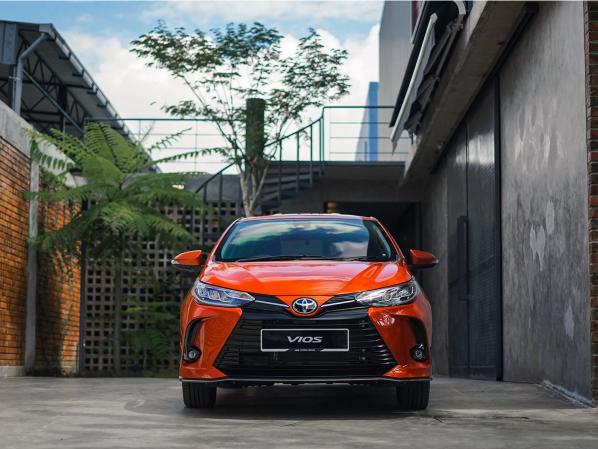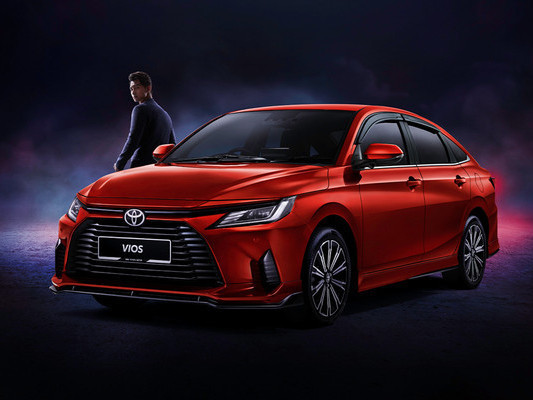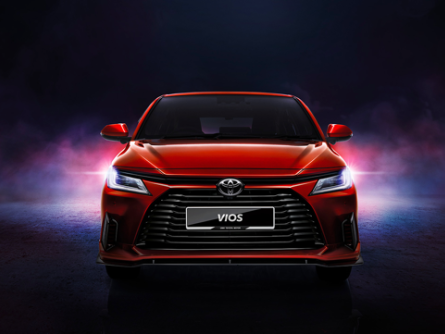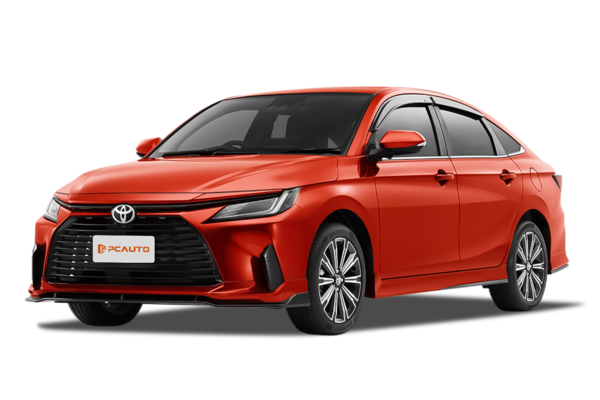Q
how much is toyota vios
The Perodua Aruz is a 7-seater compact SUV that’s perfect for Malaysian families. Its roomy interior and three-row seating setup easily fit seven passengers, making it ideal for group outings. With a 2+3+2 seat configuration, the second row splits 60:40 and the third row 50:50, giving you flexible cargo space to adapt to whatever you’re hauling that day. Under the hood, there’s a 1.5-liter Dual VVT-i engine paired with a 4-speed automatic transmission—smooth on power delivery and surprisingly fuel-efficient, whether you’re navigating city streets or hitting the highway for a road trip. Safety-wise, it comes with essentials like ABS, EBD, brake assist, and dual airbags to keep everyone protected. As Perodua’s flagship SUV, the Aruz has become a hit in Malaysia thanks to its wallet-friendly price, dependable performance, and practical design—especially for families who need extra space but don’t want to break the bank. If you’re after a high-value SUV that can handle the whole family, the Perodua Aruz is definitely one to check out.
Special Disclaimer: This content is published by users and does not represent the views or position of PCauto.
Related Q&A
Q
What is the maintenance schedule for a 2021 Vios?
For the 2021 Toyota Vios, it's recommended to get regular maintenance every 6 months or 10,000 kilometers, whichever comes first. This typically includes an engine oil change, oil filter replacement, brake system check, tire pressure inspection, and chassis bolt tightening. At 20,000 kilometers, you'll need to additionally inspect or replace the air filter and cabin air filter. Then, around 40,000 kilometers, it's a good idea to swap out the brake fluid and spark plugs to keep the engine running at its best.
Malaysia's hot and humid climate can speed up fluid degradation, so owners might want to shorten the intervals for coolant and transmission fluid changes to roughly 60,000 kilometers. It's worth noting that if you often drive in heavy traffic or take frequent short trips—what we call "severe driving conditions"—this can increase wear and tear on components. In those cases, consider changing the engine oil every 5,000-7,000 kilometers instead.
Sticking with Toyota Genuine oil as recommended by the factory, like 5W-30 viscosity, will help the engine handle the local heat better and also keep your original warranty intact. Regular maintenance isn't just about keeping performance up; it also lets mechanics use computer diagnostics to spot potential issues early. For example, checking the battery life is super important here in Malaysia to prevent starting problems during the rainy season.
Q
What is the engine of the Toyota Vios 2021?
The 2021 Toyota Vios in the Malaysian market comes with a 1.5-liter 2NR-FBE four-cylinder naturally aspirated petrol engine, featuring Dual VVT-i technology. It cranks out 107 horsepower (79 kW) and 140 Nm of torque, paired with a CVT gearbox that simulates 7 speeds. This powertrain focuses on fuel efficiency and smooth driving, with an official combined fuel consumption of around 5.1 liters/100 km. What's worth noting is the aluminum cylinder block that cuts weight, and the optimized intake and exhaust system which boosts low-end torque – perfect for Malaysia's stop-and-go city traffic. In its class, the Vios isn't about high performance, but it's known for durability and low maintenance costs, staying true to Toyota's practical reputation. If you need more power, some rivals offer turbo options, but the naturally aspirated engine still holds the edge in long-term running costs and easy repairs – that's part of why the Vios remains a hit in Malaysia's family car scene.
Q
Is Toyota Vios made in China?
The Toyota Vios in the Malaysian market mainly comes from production in Thailand, not China. As Toyota's key production base in Southeast Asia, Thailand manufactures the Vios specifically designed for the ASEAN region, making it better suited to local climate and road conditions while maintaining Toyota's usual reliability. As a global strategic model for Toyota, the Vios has different production layouts in various regions. For example, models sold in the Chinese market may be produced by local joint ventures, but the Vios supply in Malaysia is primarily imported from Thailand. This explains why Vios vehicles in Malaysia often have "Made in Thailand" on their nameplates. For Malaysian consumers, choosing a Thai-produced Vios actually has certain advantages: the Thai factory has mature craftsmanship, the parts supply chain is similar to Malaysia's, leading to relatively lower maintenance costs later on. Additionally, vehicles produced in Thailand enjoy tariff benefits under ASEAN trade agreements, which indirectly enhances the Vios' value for money in the Malaysian market. If there are doubts about the vehicle's origin, it is recommended to further confirm through the first letter of the Vehicle Identification Number (VIN) or the vehicle nameplate; typically, Thai-made Vios have a VIN starting with "M".
Q
What are common Vios problems?
The Toyota Vios is a top-selling entry-level sedan in the Malaysian market, boasting solid overall reliability. However, there are a few common issues owners should keep an eye on. For instance, some early models might experience unstable engine idling or slight vibrations, usually linked to throttle body carbon buildup or aging spark plugs—regular cleaning and maintenance are recommended. Additionally, suspension bushings on certain model years can develop squeaks after prolonged use, especially given Malaysia's rough road conditions; replacing the rubber components promptly should fix this. The CVT transmission may occasionally have minor jerking in extreme traffic jams, but regular oil changes can effectively extend its lifespan. The electric power steering system might trigger a protection mode after long hours of operation in high temperatures, causing heavier steering feel—simply turning off the engine and restarting should restore normal function. Notably, the Vios has a rather unique air filter placement, making DIY replacements a bit tricky; it’s advisable to follow the manual for that. These are all normal wear-and-tear issues. As long as you stick to the manufacturer’s recommended 10,000 km service intervals, the Vios remains quite durable under Malaysia’s hot climate and varied road conditions. For Malaysian consumers on a budget who value hassle-free practicality, it’s still a worthy option to consider.
Q
How reliable is the 2021 Toyota Vios?
The 2021 Toyota Vios has delivered impressive reliability in the Malaysian market. True to Toyota's reputation for durability, it's powered by a proven 1.5L Dual VVT-i engine paired with a CVT transmission, offering smooth power delivery and excellent fuel efficiency—perfect for local city driving. Maintenance costs are relatively low, parts are readily available, and repairs are hassle-free. Toyota's extensive after-sales service network in Malaysia further enhances the ownership experience. Based on owner feedback, common concerns mainly center on details like sound insulation and interior materials, but mechanical failure rate is extremely low. As an economy sedan, its overall performance meets or even exceeds expectations. It's worth noting that the Vios achieved a 5-star rating in ASEAN NCAP crash tests, ensuring safety. For Malaysian consumers with limited budgets who value reliability, it's a practical choice, and its resale value leads the segment, giving it an edge in long-term ownership costs.
Q
Is the Toyota Vios a SUV?
The Toyota Vios isn't an SUV—it's a compact four-door sedan (B-segment sedan), designed mainly for city commuting and daily family use. It's super popular in Malaysia thanks to its fuel efficiency, reliability, and great value for money. The Vios sits lower to the ground, with a obviously different ride height compared to SUVs (which usually have more ground clearance for rough roads), and it doesn't come with SUV staples like four-wheel drive. Instead, it's all about nimble handling and comfort. If you're after a Toyota SUV in a similar price range, check out the Raize or Rush. Both have taller ride heights and boxier body styles, making them better for different types of terrain. When Malaysian buyers are picking a car, it's important to know the difference between categories. Sedans are good for highway driving and better on fuel, while SUVs offer more ground clearance and flexible space. It really comes down to your actual needs—like the roads you'll be driving on or how many family members you have. And hey, all Toyota models in Malaysia come with a solid after-sales service network, so that's a plus.
Q
Is the 2021 Venza expensive to maintain?
The 2021 Toyota Venza's maintenance costs in Malaysia are on the upper end of the medium range. Since it comes with a hybrid system, daily upkeep expenses might be slightly higher than traditional gasoline-powered vehicles, but over the long haul, you can save some money through its lower fuel consumption. Regular maintenance like oil changes and filter replacements costs are similar to other SUVs in its class, roughly between RM400 and RM600, depending on the service center's pricing. The hybrid battery is pretty durable and generally doesn't need frequent replacement, but if it does need changing after the warranty expires, the cost could be steep. It's advisable for owners to stick to the official maintenance schedule to extend the vehicle's lifespan and keep costs in check. Malaysia's climate has minimal impact on battery performance, but regular checks of the cooling system and electrical components are still important. Toyota has an extensive after-sales service network in Malaysia with ample supply of genuine parts, which helps reduce repair waiting times and potential costs. For consumers considering a used Venza, it's recommended to check the maintenance records to ensure the previous owner kept up with proper servicing. Hybrid vehicle maintenance requires specialized technicians, so choosing an authorized service center is a smart move.
Q
What is the difference between 2021 and 2023 Toyota Vios?
The main differences between the 2021 and 2023 Toyota Vios lie in upgrades to exterior design, tech features, and safety performance. The 2023 Vios gets a more modern front-end design, including a redesigned grille and LED headlight assembly, giving it a sportier overall look. Inside, the 2023 model ups the ante with a larger infotainment screen and supports more advanced smartphone connectivity, like wireless Apple CarPlay and Android Auto, making it more user-friendly. When it comes to safety, the 2023 Vios comes standard with Toyota Safety Sense active safety suite, packing features like pre-collision warning, lane departure alert, and automatic high beam adjustment, offering more comprehensive protection compared to the 2021 version. Both models share the same powertrain – the trusty 1.5-liter Dual VVT-i engine paired with a CVT transmission – but the 2023 Vios gets some minor tweaks to boost fuel efficiency. For Malaysian consumers, the 2023 Vios upgrades are all about added value, especially with competition heating up in the segment, these improvements help it stay competitive. It's worth noting that Vios models in Malaysia usually get some market-specific tweaks to meet local needs, like beefed-up air conditioning systems to handle the tropical climate – details that carry over to both model years.
Q
How much is Toyota Vios in Indonesia?
In the Indonesian market, the price of the Toyota Vios varies depending on the trim and configuration. The base manual transmission version starts at around 270 million Indonesian rupiah (approximately RM82,000), while the top-spec automatic model can go up to 350 million Indonesian rupiah (about RM106,000). Actual prices may be affected by local taxes, promotional policies, and other factors. The Indonesian-spec Vios has slight configuration differences compared to the Malaysian version. For instance, the Indonesian market places more emphasis on practical features like rear-seat air-conditioning vents, whereas the Malaysian variant might highlight a more tech-forward feel. For Malaysian consumers considering cross-border purchases, it’s important to note the differences in vehicle specifications between the two countries, including emission standards, warranty terms, and right-hand drive vs. left-hand drive compatibility—all of which could impact the user experience and long-term maintenance costs. Additionally, the Vios is generally known for its durability and fuel efficiency across Southeast Asian markets, making it suitable for city commuting, though tuning tweaks in different countries may result in subtle variations in driving feel.
Q
What generation is Vios in 2021?
The Toyota Vios sold in the Malaysian market in 2021 belongs to the third-generation model (codenamed XP150). This generation has undergone several minor facelifts since its launch in 2013. The 2021 model continues with this generation's architecture but comes with an upgraded 1.5L Dual VVT-i engine paired with a CVT transmission, delivering excellent fuel efficiency. The third-gen Vios is widely popular in Malaysia for its durability and low maintenance costs. It measures 4,425mm in length, 1,730mm in width, and 1,475mm in height, with a 2,550mm wheelbase, offering relatively spacious rear-seat room in its class. It's worth noting that some Southeast Asian countries welcomed the all-new fourth-generation Vios based on the DNGA platform in 2023, but the Malaysian market followed suit a bit later due to strategic adjustments. The current third-gen Vios is locally assembled (CKD) with a cooling system optimized for tropical climates. It comes standard with 7 airbags (on higher-spec variants) and Toyota Safety Sense active safety technology. Its used car value retention rate has long been at the forefront of B-segment sedans in Malaysia, making it still a practical choice for budget-conscious buyers.
Popular Cars
Model Year
Car Compare
Car Photo
Latest Q&A
Q
How much did a new 2018 beetle cost?
The 2018 Volkswagen Beetle had a starting price range of approximately RM120,000 to RM180,000, depending on the trim and options. The entry-level 1.2 TSI Design model was the most affordable, while the top-spec 2.0 TSI R-Line version approached RM180,000—though final pricing could vary with optional extras and dealer promotions.
As a timeless classic, the 2018 Beetle kept its retro charm but packed modern tech like a touchscreen infotainment system and active safety features. Under the hood, buyers could choose between the fuel-efficient 1.2T or the more spirited 2.0T engine.
Fair warning: Volkswagen discontinued the Beetle in 2019, so you’ll only find it on the used market now. That said, its iconic design and nostalgic appeal still make it a hit among collectors. If you’re eyeing a pre-owned model, always check the vehicle history and maintenance records to snag a solid deal.
Q
What engine does a 2018 VW Beetle have?
The 2018 Volkswagen Beetle offered two gasoline engine options across different markets. The primary powerplant was a 1.2-liter TSI turbocharged inline-four, delivering 105 horsepower and 175 Nm of torque, paired with a 7-speed DSG dual-clutch transmission. This compact forced-induction engine struck a balance between urban fuel efficiency and strong low-end torque.
Higher-spec variants featured an optional 1.4-liter TSI turbocharged unit, bumping output to 150 horsepower. Both engines adopted direct fuel injection and belonged to VW’s widely used EA211 modular family, featuring modern tech like lightweight aluminum blocks.
Though retaining its iconic silhouette, this generation Beetle actually shared its underpinnings with the Golf, inheriting the brand’s proven front-wheel-drive architecture. This platform commonality also translated to easier maintenance, as local dealerships were well-versed in servicing these powertrains thanks to extensive parts sharing across VW’s lineup.
Q
What are the different models of the 2018 VW Beetle?
The 2018 Volkswagen Beetle comes in three main trims: Classic, Trendline, and Sport. All models are powered by a 1.2-liter TSI turbocharged engine delivering 105 horsepower, paired with a 7-speed DSG dual-clutch transmission—perfect for city driving with its nimble handling and solid fuel efficiency.
The entry-level Classic trim rolls on 16-inch wheels and features a basic multimedia system. Stepping up to the Trendline adds 17-inch wheels, fog lights, and chrome accents. The Sport trim leans into its name with 18-inch wheels, a sport-tuned suspension, and unique interior color options.
This generation keeps the Beetle’s iconic retro curves but modernizes them with touches like LED daytime running lights. Inside, you’ll find color-matched dash panels, and with 310 liters of trunk space, it’s more practical than most small cars in its class.
Since the Beetline was discontinued in 2019, the 2018 model stands as the last new generation, making it a rising collector’s item—especially the convertible, which holds strong appeal in the used market. For maintenance, stick to routine service every 15,000 km or 12 months, and regular 95-octane fuel is all it needs.
Q
Does the 2018 Beetle have Apple CarPlay?
The 2018 Volkswagen Beetle did come equipped with Apple CarPlay, integrated into its Composition Media infotainment system. This allowed iPhone users to seamlessly connect for navigation, music, and other apps. The system also supported Android Auto, catering to different smartphone users with its intuitive and responsive interface—definitely a plus for convenience on the road.
That said, some early-production 2018 models might require a software update to activate the feature, so it’s worth checking with an official dealer to confirm your car’s specs or available upgrades. Also, wireless Apple CarPlay wasn’t standard across all trims; it depended on the factory-installed options.
For fans of classic styling who still want modern tech, the Beetle struck a nice balance between retro charm and everyday usability. Competitors like the Mini Cooper offered similar connectivity, but let’s be honest—the Beetle’s iconic design was always its standout feature.
Q
What is the fuel economy of the 2018 Beetle?
The 2018 Volkswagen Beetle's fuel efficiency varies by powertrain. The 1.2L TSI turbocharged version delivers a combined fuel consumption of around 5.5L/100km, while the 1.4L TSI model is slightly thirstier at approximately 6.0L/100km – both perform best with 95-octane petrol.
You'll likely see higher consumption in city driving, but it cruises efficiently on highways thanks to its classic aerodynamic design. For better mileage, stick to routine maintenance like cleaning the air filter and keeping tyres properly inflated. These small habits can help squeeze out extra kilometres per litre.
Though discontinued, the 2018 Beetle remains popular in the used car market – its iconic styling and decent fuel economy make it a practical daily driver. Just remember real-world figures depend heavily on driving style and road conditions, so check owner forums for real-life feedback.
View MoreRelated News

Toyota Vios Interior Design Revealed: A Balance of Functionality and Aesthetics
LienJul 18, 2025

Toyota Vios : An In-Depth Buying Guide
LienMar 25, 2025

2023 Toyota Vios: 'Baby Camry' Gets an Upgrade, How to Choose Between It and the Honda City?
WilliamSep 14, 2024

Toyota Vios: Selling price starts from RM 89,600, is it a Mini Camry?
LienMay 28, 2024

2026 Toyota HiLux receives five-star ANCAP safety rating in ANCAP
MichaelDec 12, 2025
View More


















Pros
Cons